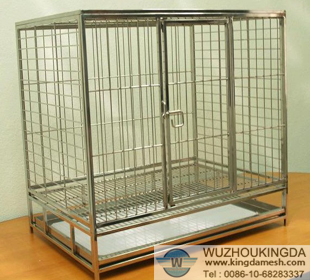History Of stainless steel Pet Cages
For as long as man has held a fascination with pets, he has understood the necessity for their housing while under his care. Despite their straightforward structure and uncomplicated intention, pet cages have transformed from simple, boxy reed and wood structures to some of the most imaginative and complicated miniature architectural configurations ever created. As time went on, and our understanding and knowledge of better avian care and husbandry developed, the stainless steel pet cages changed yet again to a more straightforward and utilitarian design.
The early bird cages were built for the very same reason we build them today: to house birds. Cages display birds, keep them safe from predators and prevent their escape. Early cages were handmade net enclosures and simple boxes created from materials such as wood, rope, woven reeds or bamboo. Later on, some birds of the past were even employed in simple, tiny cages to carry out very dirty and dangerous, yet highly respected work, such as canaries in coal mines. (The birds were used to forewarn the presence of noxious gasses; if the canary fell dead off its perch, the miners would know to evacuate the mine).
Ancient Ruins, Ancient Enclosures
Not all early cages were made in this traditional “cage structure” manner, however. An ancient ruin in the northwest corner of the Mexican state of Chihuahua called Paquime or Casas Grandes boasts the remains of a rather unusual aviary.
Before the Spanish ever crossed the Atlantic, an ancient people were breeding scarlet macaws. Paquime Indians of this Pre-Columbian, Puebloan community built and occupied an elaborate settlement made from adobe from about 900 to 1340 A.D. What was found there by archeologists was astounding: Approximately 56 macaw pens made of adobe. This site is more than 500 kilometers north of a macaw’s indigenous home.
These pens were made of adobe clay, shaped and smoothed by hand. Made of the same material that was used for housing people, they resemble a rectangular flower pot with a round plug at the end. The adobe kept the birds cooler than if they were housed in any other manner, and the pens contained stone doors and plugs. Research suggests that large-scale breeding of scarlet macaws occurred there long before the industrial age. These ancient bird breeders harvested the birds’ feathers for use in their ceremonial religious rituals, a common Meso-American practice. They most likely traded these feathers with Native American societies in the southwestern United States as well.
Roosts In The Wild/Roosts In Our Homes
The bird cage mimics a bird’s roost or home in the wild. Parrots in the wild make their homes in the hollows and cavities of trees. Birds have a natural inclination to seek a place that is enclosed. Simply put, when a cage is properly set up, a pet bird finds refuge in its cage and views it as a safe retreat to rest, relax and feel safe. The cage is regarded as the bird’s home and sanctuary. A good-sized cage with the addition of a playgym or playstand so your pet bird can spend time during the day outside of its cage is an ideal setup. This mimics a bird’s natural behavior of leaving the roost during the day and returning at night for sleep and safety. This method of keeping birds has become a more widespread practice as quality playstands have become commonly available. The designs are sturdier with additional bird-friendly features.
All birds were considered to be in vogue and stylish at this time for many reasons. Songbirds provided a background noise that was pleasing to the ear and many cages were designed to be carried from room to room with the owner. They were the first “portable entertainment” long before the transistor radio, the stereo or the iPod.
The cages that have survived time and tell the story of these eras are still coveted to this day. Known to be toxic for a bird’s housing, serious collectors often pay top dollar for the more ornate and elaborate designs, typically used for interior decorating. There is a market for rustic cages as well. Because these rustic cages were made of perishable materials, not many survived the ages, which makes them valuable.


